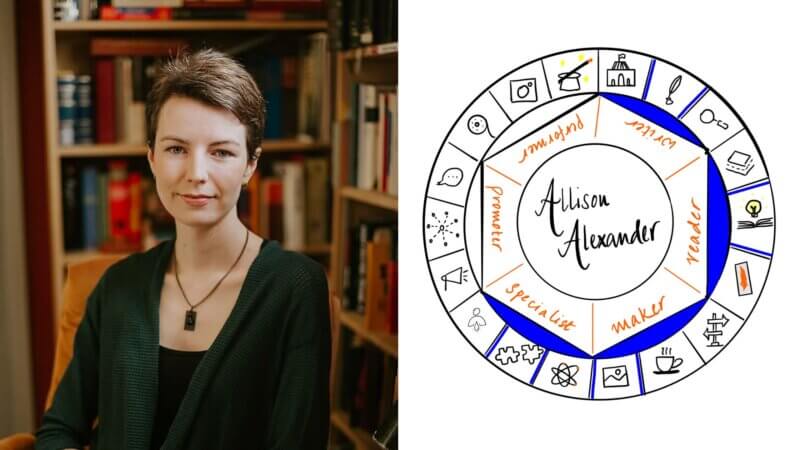Hello friend! Please welcome Allison Alexander on The Creator’s Roulette for a guest post about fantasy tropes. We connected many years back and you might remember her from Super Sick, Making Myths and Magic: A Field Guide to Writing Sci-Fi and Fantasy and our discussion on disability representation in fiction. Allison is a writer and editor specializing in sci-fi, fantasy, and nerdy nonfiction. You can find her playing D&D, chasing otter penguins off the Normandy, or co-hosting The Worldbuilder’s Tavern, a podcast for speculative fiction writers. Today, we will learn about ten Fantasy tropes in storytelling so gear up to find them in fiction as well as TV shows, movies, etc! Let’s go.
Ten Fantasy Tropes
A guest post by Allison Alexander
I love many tropes. I hate a few. But tropes exist because readers, at some point, enjoyed a thing so much that writers wrote about it again and again. Simply put, tropes are reader expectations that you can choose to meet or subvert. Unless a trope is racist, homophobic, ableist, or otherwise irredeemable, you can use it to your advantage!
Here are ten common fantasy tropes with examples of traditional and subverted uses to inspire you.
1. The Chosen One
You know the story… A young hero wannabe discovers a sword of legend, becomes a champion of destiny, overthrows a great evil, marries into royalty, and leads a kingdom into a time of prosperity. Chosen Ones usually fulfill prophecies about themselves, but often in unexpected ways. This trope is so common because one person making a difference is inspiring, and it’s become a fantasy staple.
Traditional Use: In The Wheel of Time series by Robert Jordan, Rand al’Thor is the Dragon Reborn, prophesied to bring about terrible change and fight the Dark One. Rand feels pressure because of these prophecies, especially since he’s interpreted them to mean he has to die. This is a traditional use of the trope, but it’s effective, because the author isn’t trying to surprise readers, but focuses on Rand’s character arc in relation to the prophecies.

Subverted: In the TV show Buffy the Vampire Slayer, Buffy Summers is a Slayer, part of a line of women who are bestowed with the mystical strength to fight vampires. She has prophetic dreams and is literally referred to as the “Chosen One.” But at the end of Season One, she dies. She’s revived, but only after a new Slayer is called. Suddenly, Buffy’s not the only Chosen One. The final arc of the show involves awakening all the potential slayers so they can defeat a terrible evil. The show does something surprising with the trope by creating a community of Chosen Ones instead of a lone hero.
2. The Magical Artifact of Doom
A sinister object corrupts the person carrying it. This trope is particularly unnerving, because you can’t reason with or fight against a thing.
Traditional Use: I’m sure all our minds went to The Lord of the Rings by J.R.R. Tolkien! We don’t even have to meet Sauron in The Lord of the Rings to be frightened by his power—we just have to look at Gollum to understand the affect the One Ring can have on people.
Subverted: In the anime Death Note, Light finds a notebook that kills people when their names are written in it. At first, he uses it “for good,” killing criminals in an attempt to create a better world. But he gradually starts killing whomever he feels like. The notebook itself doesn’t influence Light; it’s the power it grants that corrupts him.
3. The Quest
A hero and their group of supportive friends have a clear goal: locate the magical artifact; save the princess; defeat the big bad; or, perhaps, all of the above.
Traditional Use: In one of my favourite book series from my childhood, Deltora Quest by Emily Rodda, three characters search the land for seven missing gems from a magical belt. They solve puzzles, make friends, and fight monsters. Every book is satisfying, because it ends with the characters discovering one of the seven gems.
Subverted: In BBC’s Merlin, Arthur often thinks he’s on a quest when, in fact, it’s really Merlin’s journey that matters. In the episode “The Eye of the Phoenix,” Arthur goes off alone to retrieve the Golden Trident from the Fisher King in order to prove himself, but Merlin follows him. In the end, Merlin has a one-on-one with the Fisher King, who gives him a vial of magic water that will be important later. Arthur still retrieves the trident, but it was Merlin’s journey that was the important one.
4. The Beloved Mentor Dies
Often, the mentor dies before they can tell the hero important information (I’m looking at you, Obi-Wan). This is an emotional trope that sets the protagonist on their path.
Traditional Use: In The Inheritance Cycle, Christopher Paolini uses this trope not once, but twice: first in Eragon when Brom dies, and then in Eldest when Oromis goes away to fight.
Subverted: In the anime Fairy Tail, Guild master Makarov “dies” so many times, it becomes a running gag. He always survives in the end, either through sheer stubbornness or because guild members rescue him.

5. The Evil Advisor
Sometimes, it’s the advisor, rather than the monarch or head of state, who’s doing all the scheming. If you use this trope, it probably won’t be a surprise to the readers, but surprise is not necessary for emotional engagement.
Traditional Use: In Disney’s Aladdin, Jafar takes advantage of the kind-hearted, gullible sultan and controls him in order to take power himself. Viewers are perfectly aware of what Jafar is doing, but no one else in the story realizes until it’s too late.
Subverted: In the video game Breath of the Wild, you can find a recipe book in Hyrule Castle that has an entry for Monster Cake, which is described as the chancellor’s favourite dish… and a dish that inspires evil schemes. It’s a subtle joke about this well-known trope.

6. Traditional Fantasy Races
Fantasy readers love elves, dwarves, trolls, goblins, dragons, and other familiar species, though it can also be fun to subvert expectations and come up with your own or be inspired by lesser-known mythologies.
Traditional Use: J.R.R. Tolkien and the Norse mythology he was inspired by for The Lord of the Rings can be credited for much of our current understanding of fantasy races—elves are tall, magic, beautiful, and live in forests; dragons hoard treasure; dwarves are miners, etc.
Subverted: In the Dragon Age video games, Elves used to be a dominant race, connected to magic and nature. But after the fall of their civilization, they were enslaved. Now, they either live as nomad groups in the wilderness or in city slums, subject to prejudice and discrimination. Dwarves are builders who live underground, but they also have a complex social and political structure involving castes. The Qunari, a unique race, are white-haired, grey-skinned warrior giants who follow a religion called the Qun. Dragon Age is a master class in how to create unique societies based on race that both meet and subvert tropes.
7. The Recluse Living in the Woods
Adventurers unexpectedly meet a hermit (often one who can talk to animals and/or trees) in the woods, who shelters them for a time.
Traditional Use: In The Elfstones of Shannara by Terry Brooks, the protagonists are attacked by demon wolves, but they escape to the shelter of the King of the Silver River, a faerie creature with magic powers. He gives them advice and shelter before sending them on their way.
Subverted: In “The Puppetmaster” episode of Avatar: The Last Airbender, team Avatar meets an old woman in the woods, who offers them a place to stay. She warns them that people have been mysteriously disappearing from the woods during the full moon, but they should be safe with her. As it turns out, she is the very bloodbender who’s responsible for kidnapping the villagers. Plot twist!
8. A Woman Disguised as a Man
This trope takes place in a patriarchal society in which women aren’t allowed to become warriors or are forced to fit a specific mould. The protagonist pretends to be a man in order to achieve her goal.
Traditional Use: In Disney’s Mulan, Mulan secretly takes her father’s place when he’s called to war because she’s afraid he won’t survive. Theatrics ensue as she has to learn to fight, bathe, and even walk like a man.

Subverted: In Elizabeth Lim’s Spin the Dawn, only men can be tailors, but when her father is summoned to court to compete for the position of the royal tailor, Maia Tamarin poses as a boy and takes his place. In North American culture, sewing is usually associated with women, so this felt like a subversion to me (but note that, of course, this isn’t the case for all cultures, and Spin the Dawn is inspired by the Tang and Song Dynasties).
9. Forbidden Magic
Either all magic is forbidden because it’s considered evil, or a specific technique is not allowed because of dangerous consequences.
Traditional Use: In the anime Fullmetal Alchemist, Edward and Alphonse Elric try to bring their mother back from the dead using alchemy, and it goes horribly wrong. Edward loses an arm and a leg, and Alphonse loses his whole body, only surviving because Edward attaches his brother’s soul to a nearby suit of armour.
Subverted: In Garth Nix’s Old Kingdom series, necromancers use bells to raise the dead to serve them, which is, you know, not good. But the Abhorsen also uses the bells of a necromancer, but for good, putting the dead to rest.
10. Evil has been Locked Away for Centuries
People sealed away an ancient evil because they couldn’t figure out how to destroy it. But it’s okay, because it can never escape! Er… whoops.
These villains need to be truly terrifying, because they have a history’s worth of fear behind them.
Traditional Use: In Duma Key by Stephen King, the villain is sealed in a keg and dropped down a well, but the keg slowly leaks, causing the creature to have some influence on the world again.
Subverted: In the video game Warcraft III, Illidan Stormrage isn’t evil, but the night elves imprison him for 10,000 years because he was researching banned magic. By the time he gets out, he’s so obsessed with power and revenge that he becomes the villain.

Ten Fantasy Tropes were originally published in Allison’s newsletter, Editor’s Alchemy. It is full of ingredients for sci-fi and fantasy writers and goes out twice a month, with the first newsletter featuring an article on writing, editing, or publishing (where this post comes from), and the second newsletter showcasing new SFF book releases and reviews by yours truly, Kriti, and Ariel from Armed with a Book. 😀
Subscribe to receive the “How to Self-Edit Your Sci-Fi or Fantasy Novel” PDF!

Be First to Comment